Disclosure: Meeple Mountain received a free copy of this product in exchange for an honest, unbiased review. This review is not intended to be an endorsement.
The morning sun was beginning to steam away the dew as Tsuya (つや) stepped onto the garden path. The gravel crunched beneath her feet as she made her way deeper into the hidden sanctum of her family. Past inari (稲荷) worn smooth by the hands of her ancestors, turning right at a path blocked by a lone sekimori ishi (関森いし), she crossed the arched bridge into the deepest, most sacred part of the garden.
As she stepped from the bridge into the stone path, she paused to rinse her hands at the tsukubai (つくばい), the purifying basin. She inhaled deeply, the smells of earth, air, and smoke (from the candles in the stone lanterns) mingling with the scent of the varnish from the torii (鳥居) which had recently been repainted. As she rounded the corner and saw the large structure come into view, she was comforted. How many feet had walked this path before her, how many of her family had stood here respecting the silence, and how many had passed beneath the torii to ask for blessings from the spirits?
Tsuya sank to her knees, placing her forehead on the ground, and stilled her heart…
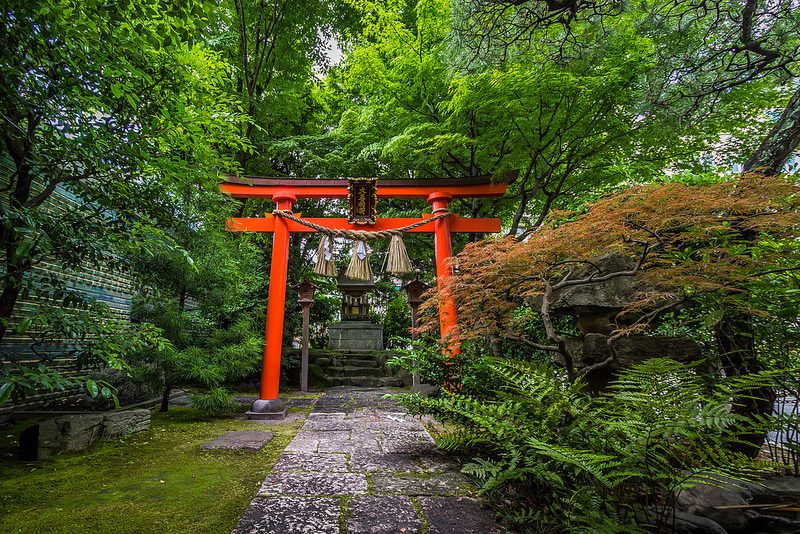
The One Hundred Torii Overview
The One Hundred Torii is a tile-laying game in the same vein as Lanterns and Carcassonne. Players lay paths through a traditional Japanese Edo-period garden, while collecting landmark tokens representing the various elements they will encounter along the way, Players may also solicit help from a number of personages during their walk; each of them offering assistance in different ways: playing two tiles, discarding tiles, blocking landmarks, etc. Players will earn points for accepting help from these people, as well as by turning in sets of landmark tokens. There are also bonus points to be earned for having various combinations of landmark tokens. The player with the most points at the end of the game is the winner.

A Quick Walk Through
While The One Hundred Torii has a relatively streamlined turn structure, playing a single tile and optionally asking for help, let’s take a moment to show you what that turn might look like.
The goal of The One Hundred Torii is to create a harmonious path through the garden which will earn you the highest number of landmark tokens. Tiles must be placed to the top, bottom, or sides of an existing tile, and at least one path on the placed tile must connect to a tile already in the garden. Players select one of the landmarks on the tile they just placed and attempt to score the path to the closest matching landmark. In the example below, the player has just placed a tile displaying a bridge landmark. The closest matching landmark exists on the starting tile. To reach that landmark the player would have to cross through two red torii. Players will always receive one token for pairing a landmark token, and will receive one matching token for each red torii they pass through on the way. Blue torii allow players to collect a token that does not match. So in this example, a player would receive three bridge landmark tokens.
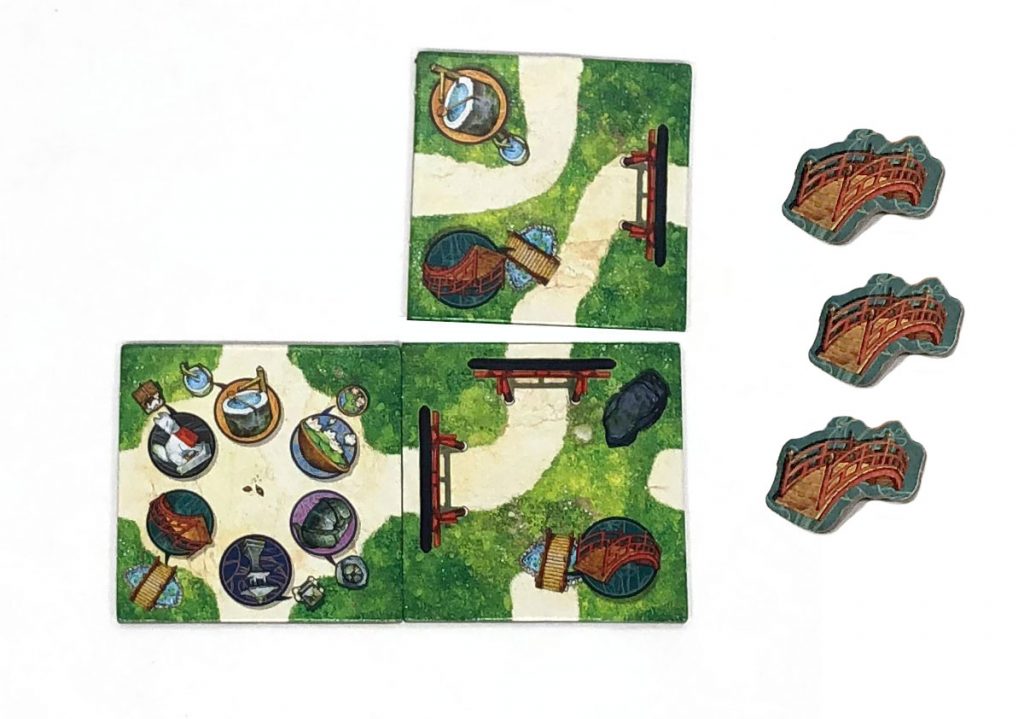
Let’s take a bit more complicated example. If the player placed the tile in the top right corner, they could choose to score either the stone, or the lantern. In either case they would pass beneath one blue torii and two red torii. That means they would receive three of either the stone or lantern, and one token of any other landmark.
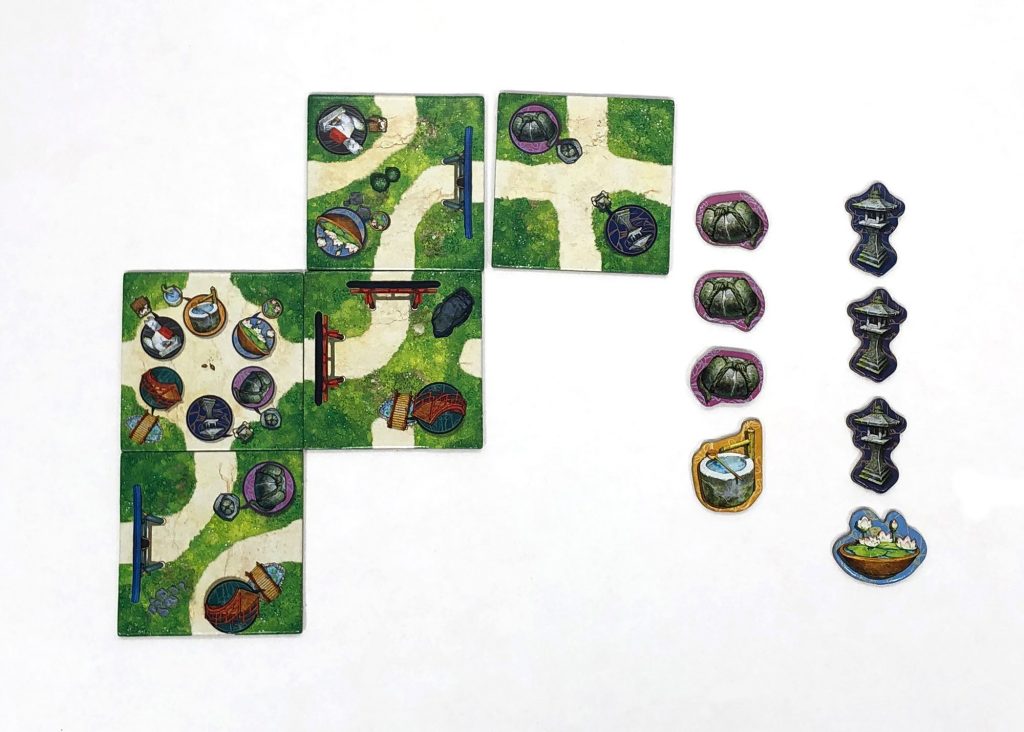
The length of the path itself makes no difference in scoring; except that longer paths provide more opportunity for passing through torii gates.
Landmark Token Collection
Upon receiving your fifth of any one type of token, trade all five in for a large version of that type, marked with a 5. You’ll now earn 5 points at the end of the game. If on a future turn you’re able to collect 5 more of that same token, then you’ll return all small tokens to the supply and flip the large 5 point token over to a 10.
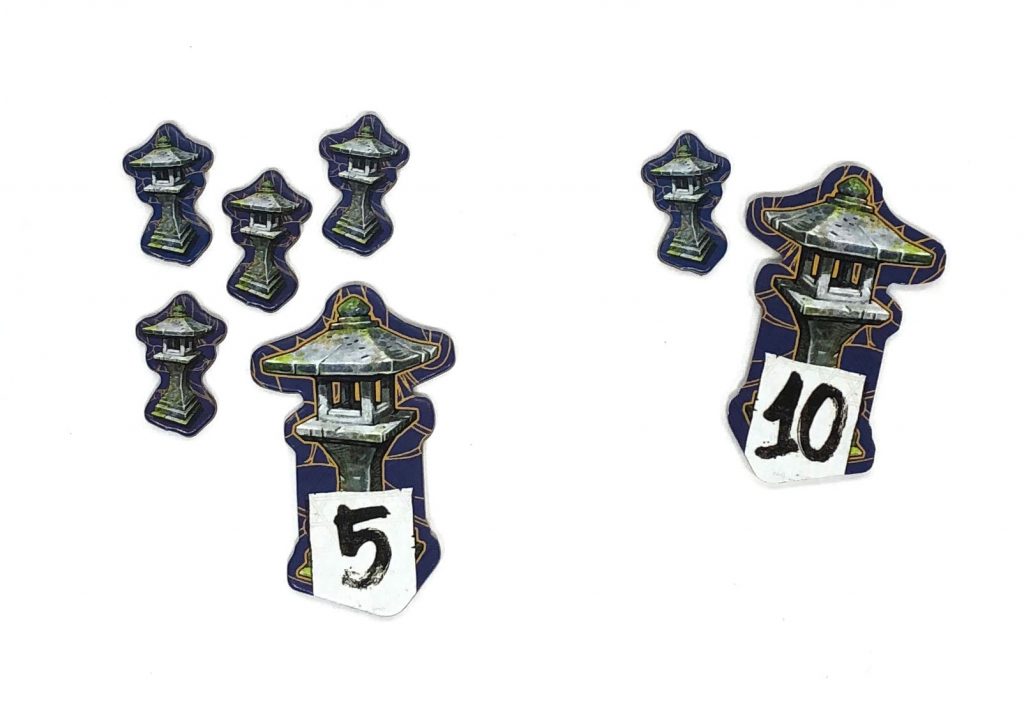
If you’re able to collect a large five point token for each of the 6 landmarks you’ll earn a special bonus tile worth an extra five points.

Finally, if you’re able to collect 3 of the 10 point pieces, you’ll score an extra special five point bonus.
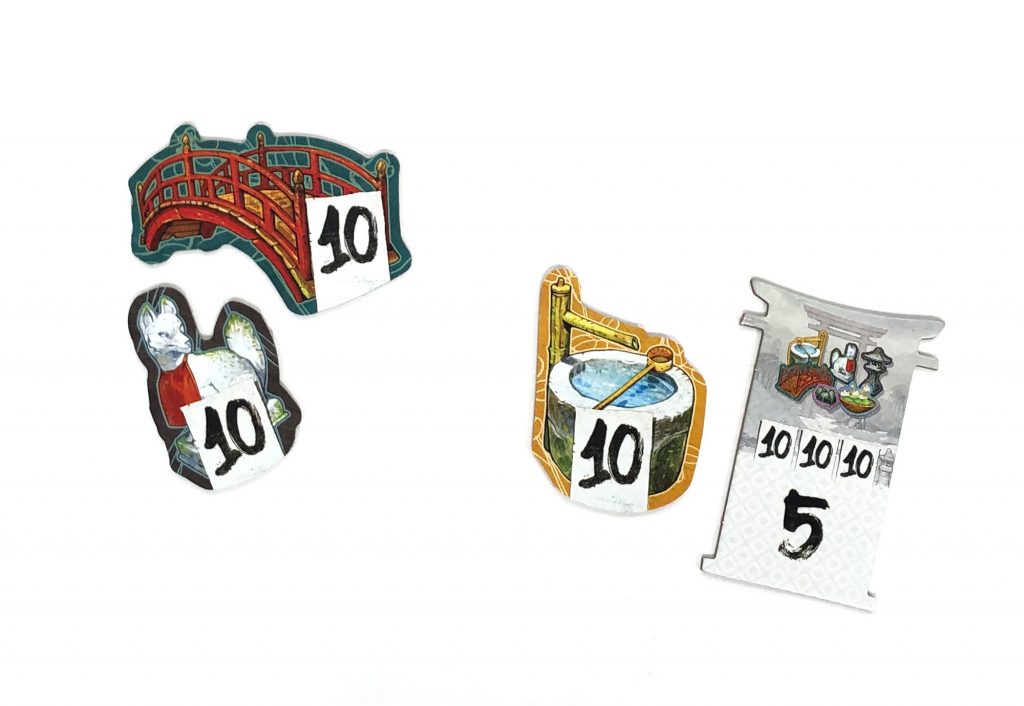
Asking for Help
The gardens of The One Hundred Torii are populated with 5 characters who are willing to offer their assistance for a price.
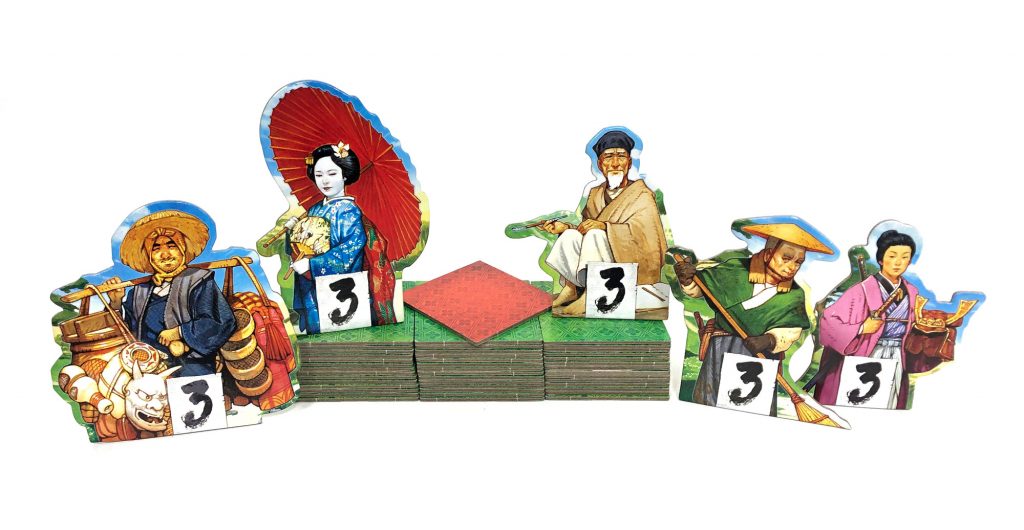
Each of these personalities can provide help with specific areas of gameplay. The Geisha allows players to place both of their tiles on a single turn, while still only allowing that player to score the second tile. The Gardener gives the player the ability to stack one of their tiles on top of an existing tile (with some restrictions). The Vendor allows you to discard 1 tile from your hand and draw two to replace it. The Samurai will block a space on the board, preventing other players from taking advantage of your tile placement. Finally The Poet allows you to cover up a landmark element on any tile, thereby making your path to the closest token longer.
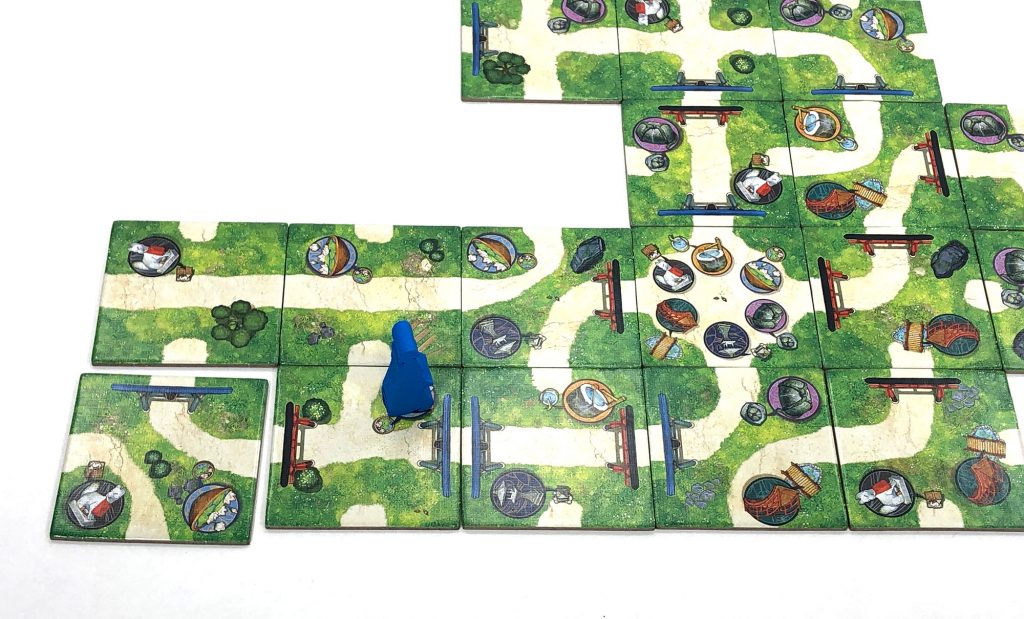
After receiving help from the patron of your choice, players will draw a matching 2 point character bonus tile. If the player has already received help from that character they would flip that tile to the 4 point side. And finally if a player receives help from a character a 3rd time, they take permanent possession of the large character achievement piece worth an extra 3 points.

Last Thoughts (最後の考え)
Before I get to my final thoughts I wanted to say how much I appreciate the commitment, dedication, and respect to which the team gave to their source material. We’ve all seen games go off the rails when treating other cultures incorrectly. But Pencil First Games really did an outstanding job with this one, kudos to the team.

It’s hard not to be pulled into a game which looks as gorgeous as this one; Vincent Dutrait has really outdone himself this time. The One Hundred Torii could perhaps be his best work to date. The colors are rich and vibrant, and the details are sublime. Everywhere you look has something new to see, some minute part of a tile that you’ve not noticed before. There’s a reason why Vincent appears in our Top 6 board game artists piece.
As mentioned previously, the gameplay is simple but engaging. Play a tile, ask for help (or not), and collect (and possibly score) your landmark tokens. But where to play the tiles, and which one to play are important in this game. You’re constantly looking to maximize the path you’re playing, while trying to avoid leaving open avenues for your opponents. If you notice that triple red torii at the end of a path, then other players will too. Then it becomes a race to see who can build onto that path first, or who can close it down.
Whether on purpose, or by chance, The One Hundred Torii is a tough game to play defensively. Sure you can look at the tokens held by other players and see what tokens they might need, but they must still have the tile which allows them to collect them. That means you’re primarily playing for yourself, and blocking your opponents happens more by chance than anything else. You can still actively prevent anyone from playing in a spot by using The Samurai, but that also penalizes you since you’d need to pay again to move The Samurai so that you can take that spot.
Which reminds me: in our games we didn’t wind up asking for help that often. It could be our exploration of the game didn’t include that option very often, but I also didn’t feel like it was lacking. I can’t help wondering if there’s too much going on in The One Hundred Torii. For a simple tile laying game, it has a surprising number of pieces.
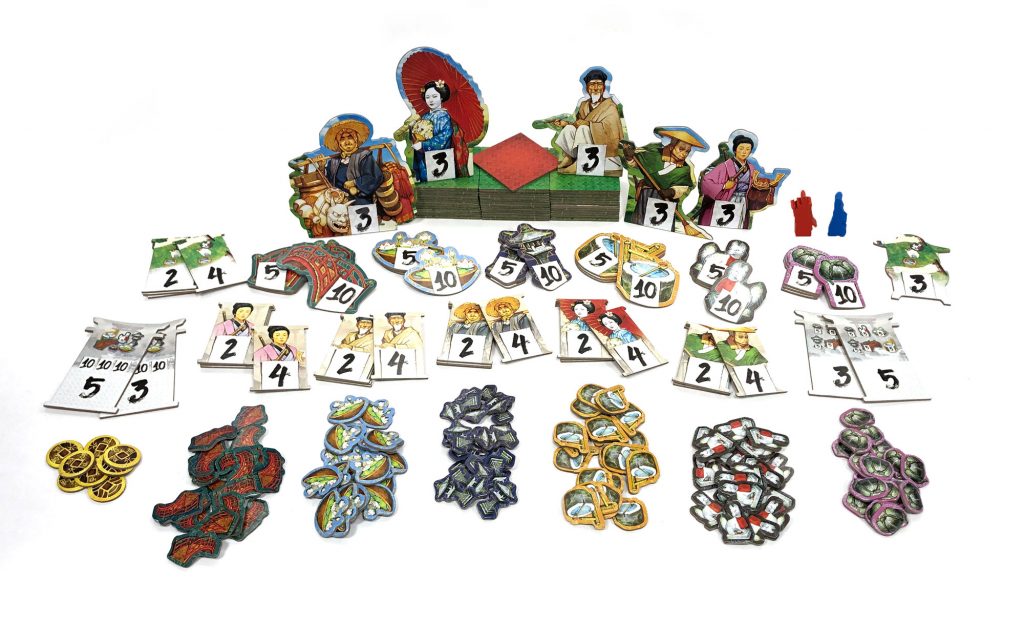
Even though the review copy I received was already punched, I was still overwhelmed when I pulled everything out of the box. Pencil First Games have indicated that an in box organization system is something they’re working on, but I don’t know if that will be included in the base Kickstarter pledge or not. The individual tokens (the smaller pieces) are essential to the game since you’re collecting and exchanging them on nearly every turn, but perhaps some of the other pieces could be negotiable?
I think that The One Hundred Torii has some interesting aspects to it: the artwork and the gameplay style. And even though I don’t think it’s breaking any new ground, it’s still a great combination of elements that you won’t find anywhere else. Pencil First Games does a fantastic job of publishing games with unique themes: herb gardens, portrait painting in the great American Wilderness, and even two player tactical war gaming!
If you’ve ever wished that Tokaido and Lanterns would have a love child then The One Hundred Torii might just be for you. This game is gorgeous, respectful to its source material, and demands you give it your full attention.












Add Comment